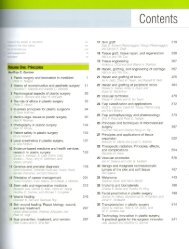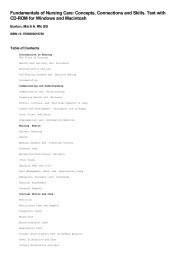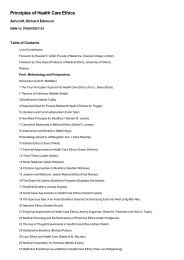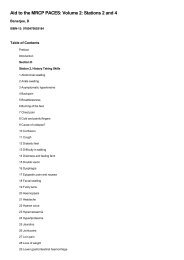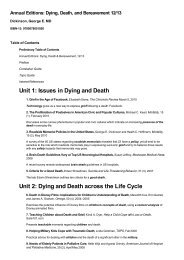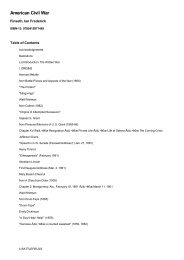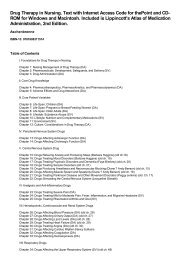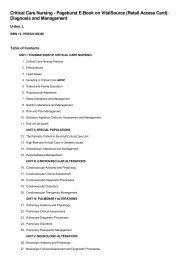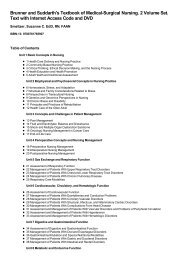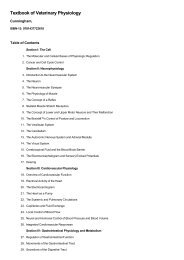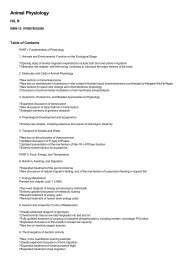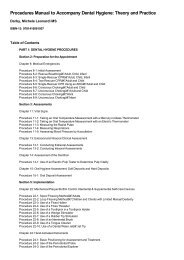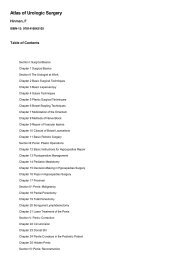Table of Contents for (9781437705874) Spine Surgery: Techniques ...
Table of Contents for (9781437705874) Spine Surgery: Techniques ...
Table of Contents for (9781437705874) Spine Surgery: Techniques ...
You also want an ePaper? Increase the reach of your titles
YUMPU automatically turns print PDFs into web optimized ePapers that Google loves.
<strong>Spine</strong> <strong>Surgery</strong>: <strong>Techniques</strong>, Complication Avoidance, and Management. 2<br />
Volume Set<br />
Benzel, E<br />
ISBN-13: <strong>9781437705874</strong><br />
<strong>Table</strong> <strong>of</strong> <strong>Contents</strong><br />
SECTION 1 - HISTORY<br />
1 - History<br />
2 - History <strong>of</strong> <strong>Spine</strong> Instrumentation - The Modern Era<br />
3 - History <strong>of</strong> <strong>Spine</strong> Biomechanics<br />
SECTION 2 - THE FUNDAMENTALS<br />
4 - Differential Diagnosis <strong>of</strong> Surgical Disorders <strong>of</strong> the <strong>Spine</strong><br />
5 - Functional Anatomy <strong>of</strong> the <strong>Spine</strong><br />
6 - Muscular Support <strong>of</strong> the <strong>Spine</strong><br />
7 - Anatomy and Physiology <strong>of</strong> Congenital Spinal Lesions<br />
8 - Anatomy and Pathophysiology <strong>of</strong> Acquired Spinal Disorders<br />
9 - Neural Injury at the Molecular Level<br />
10 - Pathophysiology <strong>of</strong> Cervical Myelopathy: Biomechanics and De<strong>for</strong>mative Stress<br />
11 - Anatomy <strong>of</strong> Nerve Root Compression, Nerve Root Tethering, and Spinal Instability<br />
12 - Physical and Neurological Examination<br />
13 - Intervertebral Disc Process <strong>of</strong> Degeneration: Physiology & Pathophysiology<br />
14 - Definition and Assessment <strong>of</strong> Dysfunctional Segmented Motion<br />
15 - Bone Modeling and Remodeling<br />
16 - The Biology <strong>of</strong> <strong>Spine</strong> Fusion<br />
17 - <strong>Spine</strong> Fusion: Anatomy and Biomechanics <strong>of</strong> the Bone-Bone Interface<br />
18 - Bone Void Fillers: Bone and Bone Substitutes<br />
19 - Osteointegration<br />
20 - Materials and Material Properties<br />
21 - Biomechanical Testing<br />
22 - Computational Modeling <strong>of</strong> the <strong>Spine</strong><br />
23 - Intervertebral Disc: Anatomy, Physiology, and Aging<br />
24 - Intradiscal Pressure<br />
25 - Fundamentals <strong>of</strong> <strong>Spine</strong> <strong>Surgery</strong><br />
26 - Preoperative and Surgical Planning <strong>for</strong> Avoiding Complications<br />
27 - Patient Selection <strong>for</strong> <strong>Spine</strong> <strong>Surgery</strong><br />
28 - Masqueraders <strong>of</strong> Spinal Pathology<br />
29 - Data Management<br />
30 - Practical Anatomy and Fundamental Biomechanics
31 - Applied Anatomy <strong>of</strong> the Cervical <strong>Spine</strong><br />
32 - Applied Anatomy <strong>of</strong> the Thoracic and Lumbar <strong>Spine</strong><br />
SECTION 3 - EXTRASPINAL Anatomy and Surgical Approaches and Exposures <strong>of</strong> the Vertebral Column<br />
33 - Occipital-Cervical Region<br />
34 - The Cervical <strong>Spine</strong> and Cervicothoracic Junction<br />
35 - Extraspinal Anatomy and Surgical Approaches to Thoracic Spnie<br />
36 - The Lumbar and Sacral <strong>Spine</strong><br />
SECTION 4 - Surgical Procedures<br />
4.1 DECOMPRESSION AND ARTHRODESIS OF THE CERVICAL SPINE<br />
37 - Upper Cervical and Craniocervical Decompression<br />
38 - Upper Cervical and Occipitocervical Arthrodesis<br />
39 - Ventral and Ventrolateral Subaxial Decompression<br />
40 - Single and Multiple-Single Interbody Fusion <strong>Techniques</strong><br />
41 - Threaded Cylindrical Interbody Cage Fixation <strong>for</strong> Cervical Spondylosis and OPLL<br />
42 - Cervical Interbody Strut <strong>Techniques</strong><br />
43 - Interbody Cages<br />
44 - Cervical Laminectomy and Lamin<strong>of</strong>oraminotomy<br />
45 - Cervical Skip Corpectomy<br />
46 - Cervical Laminoplasty<br />
47 - Interspinous, Laminar, and Facet Fusion<br />
48 - Combined Ventral-Dorsal <strong>Surgery</strong><br />
49 - Percutaneous and Minimally Invasive Approaches to Decompression & Arthrodesis <strong>of</strong> the Cervical <strong>Spine</strong><br />
4.2 DECOMPRESSION AND ARTHRODESIS OF THE THORACIC AND LUMBAR SPINE<br />
50 - Ventral and Ventrolateral <strong>Spine</strong> Decompression and Fusion<br />
51 - The Lateral Extracavitary Approach to the Thoracolumbar <strong>Spine</strong><br />
52 - Retropleural Approach to the Ventral Thoracic and Thoracolumbar <strong>Spine</strong><br />
53 - Laminotomy, Laminectomy, Laminoplasty, and Foraminotomy<br />
54 - Posterior and Trans<strong>for</strong>aminal Lumbar Interbody Fusion<br />
55 - Anterior Lumbar Interbody Fusion<br />
56 - Lumbar Interbody Cages<br />
57 - Dorsal and Lateral Thoracic and Lumbar Fusion<br />
58 - Indication <strong>for</strong> <strong>Spine</strong> Fusion <strong>for</strong> Axial Pain<br />
59 - The Black Disc: Diagnosis and Treatment <strong>of</strong> Discogenic Back Pain<br />
60 - Percutaneous and Minimally Invasive Approahes to Decompression and Arthodesis <strong>of</strong> the Thoraco- Lumbar <strong>Spine</strong><br />
61 - Thoracoscopic Corpectomy and Reconstruction<br />
4.3 TRAUMA<br />
62 - Classification <strong>of</strong> Thoracolumbar <strong>Spine</strong> Fractures<br />
63 - Trauma <strong>Surgery</strong>: Occipito-Cervical Junction<br />
64 - Subaxial Cervical <strong>Spine</strong> Injuries
65 - Trauma <strong>Surgery</strong>: Cervical <strong>Spine</strong><br />
66 - Trauma <strong>Surgery</strong>: Thoracic and Thoracolumbar Junction<br />
67 - Trauma <strong>Surgery</strong>: Lumbar and Sacral Fractures<br />
68 - Surgical Indications in <strong>Spine</strong> Trauma<br />
69 - Non-Operative Management and Treatment <strong>of</strong> Spinal Injuries<br />
70 - Medical Management <strong>of</strong> Adult and Pediatric Spinal Cord Injury<br />
71 - Spinal Injuries in Sports<br />
72 - Emerging Therapies <strong>for</strong> Spinal Cord Injury<br />
73 - Penetrating Spinal Cord Injuries<br />
74 - Timing <strong>of</strong> <strong>Surgery</strong> Following Spinal Cord Injury<br />
75 - Evaluation <strong>of</strong> the Cervical <strong>Spine</strong> After Trauma<br />
4.4 DISCECTOMY<br />
76 - Cervical Discectomy<br />
77 - Thoracic Discectomy<br />
78 - Lumbar Discectomy<br />
79 - Management <strong>of</strong> S<strong>of</strong>t Cervical Disc Herniation: Controversies and Complication Avoidance<br />
80 - Recurrent Lumbar Disc Herniation<br />
81 - Minimally Access and Percutaneous Lumbar Discectomy<br />
4.5 ARTHRITIDES AND RELATED DISORDERS<br />
82 - Cervical Spondylosis<br />
83 - Thoracic and Lumbar Spondylosis<br />
84 - Spondylolisthesis: Sagittal Plane Lumbar <strong>Spine</strong> De<strong>for</strong>mity Correction<br />
85 - Degenerative Rotatory Scoliosis: Three-Dimensional Thoracic and Lumbar <strong>Spine</strong> De<strong>for</strong>mity Correction<br />
86 - Rheumatoid Arthritis<br />
87 - Ankylosing Spondylitis and Related Disorders<br />
88 - Ossification <strong>of</strong> the Posterior Longitudinal Ligament<br />
89 - Scheuermannâ€s Disease<br />
90 - Spinal De<strong>for</strong>mity: Measuring, Defining, and Classifying<br />
4.6 DEFORMITY CORRECTION PRINCIPLES AND TECHNIQUES<br />
91 - <strong>Spine</strong> De<strong>for</strong>mity and Correction: The Fundamentals<br />
92 - Craniocervical Junction De<strong>for</strong>mities<br />
93 - Subaxial Cervical De<strong>for</strong>mities<br />
94 - Cervical Facet Dislocations: A Ventral Surgical Strategy <strong>for</strong> Decompression, Reduction, and Stabilization<br />
95 - Kyphotic Cervical De<strong>for</strong>mity<br />
96 - Scoliotic Cervical De<strong>for</strong>mity<br />
97 - Adult Thoracic and Lumbar De<strong>for</strong>mities<br />
98 - An Approach <strong>for</strong> Treatment <strong>of</strong> Complex Adult Spinal De<strong>for</strong>mity<br />
99 - De<strong>for</strong>mity <strong>Surgery</strong> <strong>for</strong> Ankylosing Spondylitis<br />
100 - Pediatric Spinal De<strong>for</strong>mities and De<strong>for</strong>mity Correction
4.7 TUMORS, VASCULAR MALFORMATIONS, AND RELATED LESIONS<br />
101 - Intramedullary Spinal Cord Lesions<br />
102 - Intradural Extramedullary Spinal Lesions<br />
103 - Spinal Intradural Vascular Mal<strong>for</strong>mations<br />
104 - Spinal Dural Vascular Mal<strong>for</strong>mations<br />
105 - Cauda Equina Syndrome<br />
106 - Primary Bony Spinal Lesions<br />
107 - Spondylectomy <strong>for</strong> Spinal Tumors<br />
108 - Prognostic Factors, Surgical Outcomes, and Guidelines <strong>for</strong> Managing Metastatic Spinal Cancer<br />
109 - Staging, Classification, and Oncologic Approaches <strong>for</strong> Metastic Tumors Involving the <strong>Spine</strong><br />
110 - Metabolic Bone Disease<br />
111 - Tumors at the Foramen Magnum: Regional Challenges<br />
112 - Cervio-Thoracic Junction Tumors: Regional Challenges<br />
113 - Thoracic and Thoracolumbar Spinal Tumors: Regional Challenges<br />
114 - Sacral Tumors: Regional Challenges<br />
115 - Tarlov Cysts<br />
4.8 PEDIATRIC SPINAL SURGERY AND RELATED CONDITIONS<br />
116 - Occult Spinal Dysraphism and the Tethered Spinal Cord<br />
117 - Myelomeningocele and Associated Anomalies<br />
118 - Anterior Sacral Meningocele<br />
119 - Chiari Mal<strong>for</strong>mation and Syringomyelia<br />
120 - Chiari Mal<strong>for</strong>mation, Chronic Fatigue Syndrome, and Fibromyalgia: A Paradigm <strong>for</strong> Care<br />
4.9 ADJUNCTIVE SURGICAL CONSIDERATIONS<br />
121 - Omental Transposistion and <strong>Spine</strong> <strong>Surgery</strong>: Emphasis on Revascularization and Scar Prevention<br />
122 - Wound Closure<br />
123 - Bone Graft Harvesting<br />
124 - Vascularized Bone Grafts in Spinal <strong>Surgery</strong><br />
125 - Pain and Spasticity<br />
126 - Minimally Invasive Spinal Decompression and Stabilization <strong>Techniques</strong> I<br />
127 - Minimally Invasive Spinal Decompression & Stabilization <strong>Techniques</strong> II: Thoracic and Lumbar Endoscopic Approaches<br />
128 - Vertebroplasty and Kyphoplasty<br />
129 - The Obese Patient<br />
130 - <strong>Spine</strong> <strong>Surgery</strong> - Smoking and the <strong>Spine</strong><br />
131 - The Geriatric Patient<br />
132 - <strong>Surgery</strong> <strong>of</strong> the Sympathetic Nervous System<br />
133 - Arachnoiditis and Syringomyelia<br />
134 - Post-traumatic and Idiopathic Syringomyelia<br />
135 - Complications <strong>of</strong> Peripheral Nerve <strong>Surgery</strong><br />
SECTION 5 - Spinal Instrumentation
136 - Basic Biomechanically Relevant Anatomy<br />
137 - Spinal Implant Attributes: Distraction, Compression, and Three-Point Bending<br />
138 - Implant Attributes: Cantilever Beam Fixation<br />
139 - Cervical <strong>Spine</strong> Fusion using Dynamic Ventral Cervical Plating<br />
140 - Cervical <strong>Spine</strong> Construct Design<br />
141 - Thoracic and Lumbar <strong>Spine</strong> Construct Design<br />
142 - Upper Cervical Screw Fixation <strong>Techniques</strong><br />
143 - High Cervical and Occipitocervical Plate, Rod, Wire, and Bone <strong>Techniques</strong><br />
144 - Ventral Subaxial Cervical Fixation <strong>Techniques</strong><br />
145 - Subsidence and Dynamic Cervical <strong>Spine</strong> Stabilization<br />
146 - Ventral and Lateral Thoracic and Lumbar Fixation <strong>Techniques</strong><br />
147 - Dorsal Subaxial Cervical Instrumentation <strong>Techniques</strong><br />
148 - Dorsal Thoracic and Lumbar Screw Fixation and Pedicle Fixation <strong>Techniques</strong><br />
149 - Dorsal Thoracic and Lumbar Simple Hook-Rod, Wire and Wire-Rod <strong>Techniques</strong><br />
150 - Dorsal Thoracic and Lumbar Universal Spinal Instrumentation <strong>Techniques</strong><br />
151 - Dorsal Thoracic and Lumbar Combined and Complex <strong>Techniques</strong><br />
152 - Complex Lumbosacropelvic Fixation <strong>Techniques</strong><br />
153 - Iatrogenic <strong>Spine</strong> Destabilization<br />
154 - Lumbar Facet Fixation <strong>Techniques</strong><br />
155 - Para-coccygeal Trans-sacral Approach to the Lumbo-Sacral Junction <strong>for</strong> Interbody Fusion and Stabilization<br />
SECTION 6 - MOTION PRESERVATION STRATEGIES<br />
156 - To Not Operate<br />
157 - Motion Sparing, Non-Implant <strong>Surgery</strong>: (A) Cervical <strong>Spine</strong>; (B) Lumbar <strong>Spine</strong><br />
158 - Adjacent Segment Degeneration & Disease <strong>of</strong> the Cervical and Lumbar <strong>Spine</strong><br />
159 - Biomechanics <strong>of</strong> Motion Preservation <strong>Techniques</strong><br />
160 - Cervical Total Disc Arthroplasty<br />
161 - Lumbar Total Disc Arthroplasty<br />
162 - Second Generation Total Disc Arthroplasty<br />
163 - Nuclear Replacement<br />
164 - Dorsal Dynamic <strong>Spine</strong> Stabilization<br />
165 - Artificial Facet Joint<br />
166 - Interspinous Bumpers<br />
167 - Total Disc Arthroplasty - Associated Complications<br />
168 - Explant Analysis <strong>of</strong> Wear, Degradation, and Fatigue in Motion Preserving Spinal Implants<br />
SECTION 7 - ADJUNCTS TO SURGERY<br />
169 - Surgical Incisions, Positioning, and Retraction<br />
170 - Blood Loss<br />
171 - Imaging: Trauma<br />
172 - Degenerative Disease and Infection: Role <strong>of</strong> Imaging
173 - Overview <strong>of</strong> Imaging Procedures Available <strong>for</strong> Spinal Diagnosis<br />
174 - Postoperative Imaging<br />
175 - Intraoperative Imaging<br />
176 - Stereotactic Radiosurgery <strong>for</strong> the Treatment <strong>of</strong> Spinal Metastases<br />
177 - Somatosensory Evoked Potential <strong>for</strong> Spinal <strong>Surgery</strong><br />
178 - Electrodiagnostic Studies<br />
179 - Intraoperative Nonparalytic Monitoring<br />
SECTION 8 - NONSURGICAL MANAGEMENT<br />
180 - Anesthesia<br />
181 - Advances in Anesthesia <strong>for</strong> <strong>Spine</strong> <strong>Surgery</strong> and the Prevention <strong>of</strong> Complications<br />
182 - Perioperative Management<br />
183 - Medical Management <strong>of</strong> the Patient with Acute Spinal Cord Injury<br />
184 - Nutritional Care <strong>of</strong> the Spinal Cord Injured Patient<br />
185 - Skin and Wound Care<br />
186 - Spinal Traction<br />
187 - Orthoses: Complication Prevention and Management<br />
188 - Medical Management <strong>of</strong> Neck and Low Back Pain<br />
189 - Non-Operative Management <strong>of</strong> Neck and Back Pain<br />
190 - Psychosocial Aspects and Work-related Issues Regarding Lumbar Degenerative Disc Disease<br />
191 - Interventional Non-Operative Management <strong>of</strong> Neck and Back Pain<br />
192 - Intradiscal Electrothermy<br />
SECTION 9 - SPECIFIC COMPLICATIONS: AVOIDANCE AND MANAGEMENT<br />
193 - Neurologic Complications <strong>of</strong> Common Spinal Operations<br />
194 - Vascular and S<strong>of</strong>t-Tissue Complications<br />
195 - Postoperative Spinal De<strong>for</strong>mities<br />
196 - Arachnoiditis<br />
197 - <strong>Spine</strong> Infection<br />
198 - The Prevention <strong>of</strong> Operative Infections: An Evidence-based Approach<br />
199 - Medical Complications<br />
200 - Cerebrospinal Fluid Fistula and Pseudomeningocele After <strong>Spine</strong> <strong>Surgery</strong><br />
201 - Nonunion<br />
202 - Spinal Reoperations<br />
203 - Intraoperative Crisis Management in <strong>Spine</strong> <strong>Surgery</strong>: What to do When Things Go Bad<br />
**THE FOLLOWING SECTIONS WILL ONLY BE ON-LINE AND NOT IN THE PRINTED TEXT**<br />
SECTION 10 - POSTSCRIPT<br />
204 - Ethical and Mediocolegal Aspects <strong>of</strong> Spinal <strong>Surgery</strong><br />
205 - Conflicts <strong>of</strong> Interest and Conflict Management
206 - Economics and Practice Management<br />
207 - The Rationale <strong>for</strong> Practice Hygiene: Coding, Reimbursement, and Nomenclature<br />
208 - Education <strong>of</strong> the <strong>Spine</strong> Surgeons<br />
209 - Education and Knowledge-Base Acquisition and Retention<br />
210 - The Art <strong>of</strong> the Clinical Trial<br />
211 - The Meaningful Retrospective Analysis<br />
212 - Art and Science <strong>of</strong> Guideline Formation<br />
SECTION 11 - CONTROVERSIES<br />
213 - Anterior Cervical Corpectomy and Fusion: To Plate or Not To Plate<br />
To Not Plate<br />
To Plate<br />
214 - Cervical Spondylosis with Minimal Myelopathy: To Decompress or Not To Decompress<br />
To Decompress<br />
Not To Decompress<br />
215 - Bilateral Locked Cervical Facets with Incomplete Myelopathy: Open Versus Closed Reduction<br />
Open Reduction<br />
Closed Reduction<br />
216 - Cervical <strong>Spine</strong> Fusion: Allograft Versus Autograft<br />
Argument <strong>for</strong> Allograft<br />
Argument <strong>for</strong> Autograft<br />
217 - Thoracic and Thoracolumbar <strong>Spine</strong> Fractures with Ventral Mass Lesion: Ventral Versus Dorsal<br />
Operation<br />
Ventral Decompression and Stabilization<br />
Dorsal Decompression and Stabilization<br />
218 - Reoperation <strong>for</strong> Failed Spinal Fusion: Augmentation <strong>of</strong> Fusion with Spinal Stimulation<br />
Argument Against Bone Growth Stimulator<br />
Argument <strong>for</strong> Bone Growth Stimulator<br />
219 - Management <strong>of</strong> a Patient with Thoracolumbar Fracture with Complete Myelopathy and a 40° Kyphotic<br />
De<strong>for</strong>mity: Operative or Recumbent Management<br />
Operative Management<br />
Recumbent Management<br />
220 - Management <strong>of</strong> Symptomatic Osteoporotic Vertebral Compression<br />
Vertebroplasty<br />
Kyphoplasty<br />
221 - Management <strong>of</strong> Ossification <strong>of</strong> Posterior Longitudinal Ligament<br />
Cervical Laminoplasty - Open Door<br />
Laminoplasty - French Door<br />
Laminectomy<br />
Ventral Approach: Smith-Robinson Approach
Ventral Approach: Open Window Corpectomy<br />
222 - Spondylotic Myelopathy with Cervical Kyphotic De<strong>for</strong>mity<br />
Ventral Approach<br />
Dorsal Approach<br />
Combined Ventral and Dorsal Approach<br />
223 - Management <strong>of</strong> Cervical Disc Herniation<br />
Dorsal Lamin<strong>of</strong>oraminotomy Plus Discectomy<br />
Ventral Cervical Discectomy and Fusion with Allograft or BMP and Plating<br />
Anterior Cervical Discectomy and Fusion with Autograft and Without Plating<br />
Anterior Cervical Discectomy with Artificial Disc<br />
224 - Management <strong>of</strong> a 45-year old with Mechanical Low Back Pain and with or without L4/5 Spondylolisthesis and No<br />
Neurological Findings<br />
Non-Operative Management<br />
Spinal Fusion - Ventral Approach<br />
Spinal Fusion - Dorsal Approach<br />
Spinal Fusion - Dorsal & Ventral Approach<br />
Total Disc Arthroplasty<br />
Nuclear Replacement<br />
225 - Management <strong>of</strong> Traumatic Unilateral Jumped Cervical Facet Joint Without Myelopathy<br />
Closed Traction Reduction Then <strong>Surgery</strong><br />
Open Reduction<br />
226 - Management <strong>of</strong> Traumatic Bilateral Jumped Cervical Facet Joints in a Patient with Incomplete Myelopathy<br />
Closed Traction Reduction Then <strong>Surgery</strong><br />
Open Reduction<br />
227 - Management <strong>of</strong> Traumatic Bilateral Jumped Cervical Facet Joints in a Patient with Complete Myelopathy<br />
Closed Traction Reduction Then <strong>Surgery</strong><br />
Open Reduction<br />
228 - Timing <strong>of</strong> Decompression <strong>Surgery</strong> <strong>for</strong> Traumatic Spinal Cord Injury in a Patient with an Incomplete Myelopathy<br />
Postural Non-Operative Management<br />
Emergent <strong>Surgery</strong><br />
Non-Emergent <strong>Surgery</strong><br />
229 - Timing <strong>of</strong> Decompression <strong>Surgery</strong> <strong>for</strong> Traumatic Spinal Cord Injury in a Patient with Complete Myelopathy<br />
Postural Non-Operative Management<br />
Emergent <strong>Surgery</strong><br />
Non-Emergent <strong>Surgery</strong><br />
230 - Medical Management <strong>of</strong> Acute Spinal Cord Injury<br />
Administration <strong>of</strong> High-Dose Steroids<br />
No Administration <strong>of</strong> Steroids<br />
231 - Traumatic Central Cord Syndrome
Early <strong>Surgery</strong><br />
Delayed <strong>Surgery</strong><br />
232 - Cervical Disc Herniation with Radiculopathy<br />
Anterior Cervical Discectomy with Interbody Fusion<br />
Anterior Cervical Discectomy with Interbody Fusion with Plating<br />
Anterior Cervical Discectomy with Artificial Disc Spacer<br />
Anterior Cervical Discectomy without Fusion<br />
(management <strong>of</strong> cervical disc herniation & cervical disc herniation with radiculopathy)<br />
Lamin<strong>of</strong>oraminotomy<br />
233 - Traumatic Assymtomatic Vertebral Artery Injury Secondary to Facet Fracture Dislocation<br />
Do Nothing<br />
Endovascular Management<br />
Medical (anticoagulation) Management<br />
234 - Lumbar Fusion versus Total Disc Arthroplasty <strong>for</strong> Mechanical Low Back Pain<br />
Fusion<br />
Total Disc Arthroplasty



